

With this mold, the 2X3 brick was introduced in the LEGO Mürsten system.
The brand name "LEGO" was conspicuously carved in the mold. This may suggest a need to diferentiate from immitators. Since the10X20 thin baseplate issued in 1951 was originally not similarly marked, this mold is more recent. Indeed, the early leaflets illustrating the baseplate do not show this brick or mention it as part of the complement of the boxed sets.
The "LEGO" script occupies fully one third of the bottom area. No mold unit numbers are engraved. Looking from beneath into the brick interior, thin longitudinal ribs will be noticed. These were probably carved in the mold to help with the ejection process.
This is the only 2X3 mold used for colours that had seemingly been abandoned by 1953, such as light green and marbleized.
Molds were made at this time to produce only single slotted bricks and the opposed slotted bricks, in line with 2X4 and 2X2 production of the era.
NOTE: In LEGO bricks the slots are molded and not cut and thus the same molding unit always produces the same type of slotted brick.

The "LEGO" script is much smaller than in 2X3vs01a. Originally the logo was rather shallow and the mold units were unnumbered. Subsequently each mold unit was marked with a faint mold number inscribed by hand and the logo was deepened and made very conspicuous which suggests a clear intention to diferentiate the product from immitations (see this page on altered molds).
Seen from beneath, the interior ribs are transversal and not longitudinal (one is clearly seen in the lower part of the interior of the right brick above).
Only the two basic slot combinations seem to have been produced. The mold unit numbers according to type are:
-mold nr 1 - single slotted;
-mold nr 2- double slotted.

This is a different mold from the previous, probably made necessary to produce the two additional slot positions that had meanwhile been introduced to the system. Seen from beneath, there are no interior ribs, but four circular marks (one left, two central and one right) are noticed. These are the imprints of ejector pins that separate the part from the mold and have, for the first time, been used (they are clearly seen in the interior of the red brick in the figure above).
Each brick is marked with a distinct, protruding, mold number machine-engraved to the mold.
For the first time with this mold, the four slot combinations were produced. The mold numbers according to type were:
-mold nr 1 - single slotted;
-mold nr 8 - double slotted;
-mold nr 4- slots at 90º as the yellow brick above;
-mold nr 5- slots at 90º as the red brick above.
The remaining mold unit numbers correspond to 2X8 and 2X10 bricks that, thus, shared the same mold.
NOTE: this mold was produced by a different maker and it is much less polished than the molds previously made. It must have been a particularly expensive mold, because of the brick types produced, their size, and the need for many ejection pins. It was one of the rare molds to have survived the Mürsten era- it was re-machined to cut off the protrusions that opened the slots and used into 1956. In the bricks made with the re-machined mold, the slot positions are still faintly visible because the machining of the hardened mold left small burrs.

Circa 1954 a new mold was produced. The main difference is now the so-called LEGO "dogbone" logo engraved inside.
Mold numbers inscribed near the logo (the transparent brick above is nr 1).
From above, the sides of the studs are seen to be sometimes taller than the top. This is caused by the intrusion of plastic in the periphery of ejector pins positioned over the stud tops.
Bricks were still slotted and mold units were made at this time to produce the opposite slotted brick (mold nr 7) and the 90º slots (nrs 1 and 2).

The problem with the concavity of the stud surfaces on high speed injection molding, seen e.g. on the 1X2 bricks, called for thinner stud walls, and so in the first molds for non-slotted bricks produced by LEGO, the studs were hollowed.
Another feature was introduced in all the new molds: the "LEGO" logo on the studs.
All mold numbers seen were machine engraved.

The fourth version of the 2X3 brick is easily distinguished by the underside tubes that connect firmly each brick with the brick below.
The studs are hollow with a diameter of circa 3mm, as in the previous version.
All bricks bear underside the note "Pat. pend." above and below the central tube. Mold units are identified by simple numerals set above the tube. The red brick pictured is "3".
This was the first type confirmed sold in Portugal from 1957/58.
 |
 |
New molds were introduced circa 1960. These are distinguished by the smaller diameter hollow of the studs, correcting a possible fragility of the previous version. Above 2X3vs04 is left; the new 2X3vs05 is on the right side.
Stud hollows are encircled by a ring, likely the imprint of ejector pins in the mold, faintly seen on top the adjoining brick..
The first mold or molds were identified by a number only, subsequent molds identified by a code consisting of a number and a letter on opposite sides of the underneath.